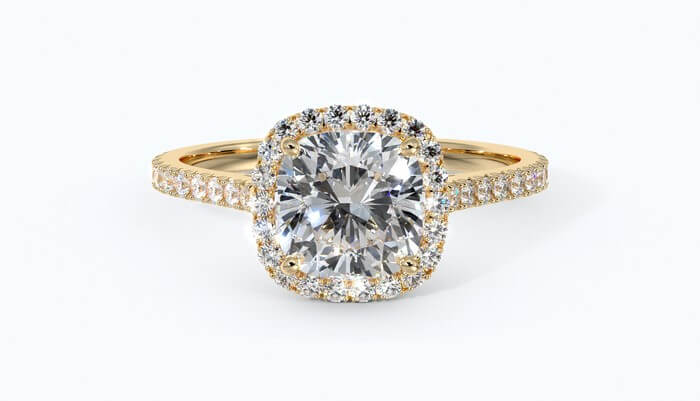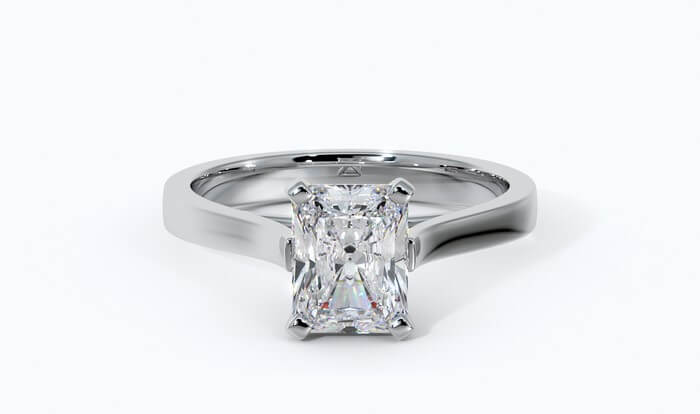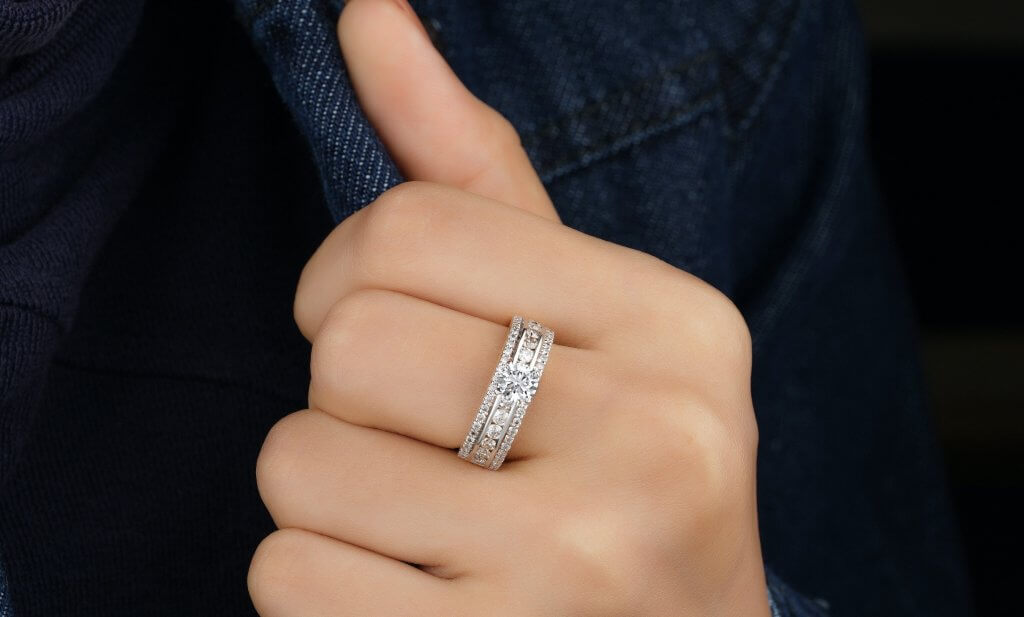Cushion Halo Ring: The Complete Guide
Key Takeaways
- Cushion halos can give your ring a little more sparkle.
- They can boost the color, which is important when keeping in mind that the Cushion cut can be less complementary to stones affected by a hint of color.
- The right halo can boost the color, though it cannot literally improve the center stone’s color itself.
- They can also boost the size. Again, this is important, as Cushion cuts are known to have a smaller face-up appearance than other popular shapes.
- The halo can be a perfect choice for anyone who has a flair for luxury and glamour, but make sure to do your research. There may be other variations a jeweler can work on to create something unique to you.

The Cushion cut is a crowd favorite for a very good reason – or, more accurately, a number of reasons. From its plush appearance to that dazzling display of colorful fire it creates when the light hits – not to mention its versatile, classic shape – the Cushion is a timeless choice for your engagement ring.
While the laid-back Cushion solitaire may be a genuine rival to the Round Brilliant solitaire, there’s something irresistible about turning up the dial on luxury, and pairing a beautiful Cushion cut with a bright, lavish halo setting.
This style has garnered plenty of attention over the years, with Sofia Vergara and Alison Pill both wearing Cushion cut halo engagement rings.
Here is everything you need to know about pairing this cut with a halo.
Cushion Halos: The Benefits
Halos bring more to a ring than a little extra sparkle – and, for a Cushion cut in particular, there are plenty of benefits to adding one into your design. Here are our most compelling arguments in favor of a Cushion halo.
They can boost Color
Cushion cut diamonds are valued highly for their plush shape and the intense fire that creates, but one of the potential downsides to the shape’s depth and unique light performance is that it can be a little less complementary to stones affected by a hint of color.
We say this is a ‘potential’ downside for two reasons. One is that, while Cushion cut diamonds can show color worse than some other shapes, it’s still perfectly possible for you to find a beautiful Cushion cut diamond without having to spend hundreds of dollars extra on a Colorless grade. A G or H color grade may be the best for you, although, for smaller stones, you’ll still find options in the I color range. Nevertheless, you don’t want to risk going too low and winding up with something that betrays itself under certain lighting conditions.
The other reason the Cushion’s ability to retain color is only a potential downside is because, for those seeking fancy color diamonds, this particular quality means that the Cushion represents one of the best choices. Colors can appear a little more vivid in Cushion cut diamonds, which is a major plus if fancy color is what you’re after.
Then again, the majority of people out for an engagement ring are looking for a white (colorless) diamond, which means working to find that sweet spot between overspending on a ‘perfect’ diamond, and wasting that entire investment on a diamond that looks yellow.
There are ways of complementing a diamond that isn’t quite perfect in terms of color, and one of the most effective is combining it with a halo that boosts the appearance of colorlessness.
Can halo settings really improve a diamond’s color?
While they can’t literally improve the center stone’s color, the right halo can appear to give it a boost. For this reason, jewelers typically create the halo out of melee diamonds that are one or two color grades lower than the center stone (without going so low that they start to appear yellow).
If the jeweler were to use melee diamonds with a better color grade than the center stone, then the slight contrast could give the appearance of a diamond with a more discernible yellow tint.
Don’t use this as an excuse to invest in a Cushion cut with noticeable color, however. While halos can make a slight difference, they can’t totally transform a diamond into something far superior, and believing you can make a K diamond look like a G diamond with a halo is only going to cause disappointment further down the line.
They can also boost size
Another minor downside to the Cushion cut is the fact that, compared with other popular shapes, it has a smaller face-up appearance. By this, we mean that, when you’re viewing the stone from above (rather than side-on) it appears to be smaller than other diamonds of the same carat weight. This is an essential part of the cut since the high level of fire the Cushion creates is a result of its depth. More carat weight is held below the girdle, rather than in the crown.
For comparison, a 1 carat Round Brilliant should measure approximately 6.5 mm across, whereas a 1 carat Cushion cut to the right proportions will measure 5.5 mm. A 1 carat Princess cut (another square shape) will also measure 5.5 mm across, but its distinctively sharp corners tend to create the illusion of a greater width and length.
The difference is relatively minor, but it can be enough to deter some shoppers away from the Cushion, even in spite of their love of the shape. There are, however, plenty of setting types capable of making diamonds look bigger, and the halo is one of the crowd favorites…
How many carats does a halo add?
In general, a typical halo will create the illusion of a center stone around half a carat larger than it really is. As we mentioned, this illusion can be thrown off-balance if the halo is too large or cumbersome, but, as a general rule, this can be useful to keep in mind if you’re still on the fence about a halo setting.
What’s more, if your diamond is too small to start with, a halo is unlikely to make it look any bigger. Try not to go below the 0.75 carat mark, or everything may appear to be part of one, solid cluster.
They heighten your diamond’s sparkle
We’ve already mentioned a couple times how the Cushion cut’s distinctive light performance is one of its most popular features, but, as with any other cut, there will always be some trade-off involved when you decide not to get a Round Brilliant for your center setting.
For most shapes, this trade-off is relatively minor. Obviously, for a step cut like the Emerald, shoppers have to make a much, much bigger sacrifice in terms of fire and brilliance but, when it comes to modified brilliants like the Cushion, the loss of sparkle isn’t too significant.
But, if a part of you still wants to boost the overall sparkle of your ring, then the halo is the most effective option. It’s great for adding a little extra brilliance to complement the fire of the Cushion, since halos are almost always created using Round Brilliant melee diamonds (obviously the best choice for getting more of those stark, white flashes of light).
They’re versatile
The name ‘halo’ instantly calls to mind images of those circular rings of melee diamonds but, these days, halos can be created in all kinds of shapes. Marquise halos and Pear halos, for instance, can follow the silhouettes of these shapes, and ensure none of that definition is lost or obscured by the melee diamonds.
The same goes for square shapes, like the Cushion and Princess. Square halos keep these shapes’ corners defined, and maintain a strong visual difference between them and the softer Round Brilliant. These days, some shoppers even choose to pursue a combination of a square halo with a round diamond, in order to take advantage of the two shapes.
The Cushion gives you the best of both worlds. You could choose to combine it with a square halo with rounded corners, for the most exact fit, or with sharpened corners for a more modern look, without having to switch your stone out for a Princess cut. In this way, it’s possible for you to choose between a softer silhouette, and one with a little more edge to bring out a more contemporary side to the shape.
Things to Consider
As with any setting type, there are a few other factors to consider.
Metal
Keep in mind that a diamond surrounded by a halo will naturally take on the color of your chosen metal a little more than it would if it were simply held in place using a basic four or six prong setting. This is particularly true for a Cushion. Its ability to retain color means that it will naturally reflect a white or rose gold setting quite noticeably.
This isn’t necessarily a negative. A lot of people love the look of gold reflecting through the center of a diamond – plus, it takes off the pressure to invest in a perfectly colorless diamond.
Nevertheless, it’s something to consider. A white gold or platinum center setting may be your best option if you’re going for that start, modern, crisp look, while the more romantic and warmer tones of yellow and rose gold will look beautiful in a totally different way.
How Many Halos?
We’ve already mentioned how anyone using a halo setting is walking a fine line between complementing their diamond, and overwhelming it. Double halos can look great on the right ring – they create an incredibly scintillating, impressive center setting perfect for people with more outgoing styles – but, in other rings, they can look totally out of place.
Your jeweler will be your best source of advice on this subject. Complementing any diamond means knowing when to add detail, and when to leave it out, and no one will understand that process better than someone who has devoted years to the craft.
Ultimately, there’s nothing wrong with creating a bulky, triple-halo ring, but don’t make the mistake of thinking that creating a halo ring is a case of, ‘Go big or go home’.
Get used to reading about ‘CTTW’
CTTW – also known as CTW – refers to the Carat Total Weight of a ring. This is, put simply, the combined carat weight of all diamonds, from the center stone to the accent and melee diamonds, used to create a ring.
1 carat diamond solitaires have a CTTW of 1, but rings featuring halo or pavé settings can have CTTWs much higher. It’s worth understanding the difference just in case you come across a ring with a CTTW of 2 and presume that refers solely to the center stone.
Nevertheless, with a good jeweler, you won’t run afoul of those mistakes.
You’ll still want to consider the prong type
While they’re not so easy to spot on halo rings as they are solitaires, prongs are still an essential part of the overall design, and you’ll want to make sure you pay enough attention to these smaller details.
You can take a look at our guide to the different types of prong settings for more information on this subject.
If you’re worried about going overboard, consider a hidden halo instead
Halos are beautiful and popular features, but they’re not quite everyone’s ‘cup of tea’. For starters, the added bulk isn’t always the most comfortable to wear, particularly if the wearer has a busy lifestyle, and, beyond that, the halo is a little more vulnerable to changing trends than some other ring designs.
That fact alone should not deter you from a halo if you know it’s up your partner’s street but, if there’s a part of you worrying about going for a full-blown halo, then a hidden halo may be the perfect choice.
Instead of encircling the full perimeter of the diamond, a hidden halo sits at the base of the pavilion, underneath the center setting. From above, it’s totally out of view but, when the ring is viewed from the side, it creates a beautiful, sparkling feature that doesn’t detract from the simplicity of the overall design.
Our Summary
It should come as no surprise that the halo is a particularly popular accompaniment to any diamond shape. Special commendations do, however, go out to the halo – the combination of that sumptuous, pillowy shape and the opulent halo is a match made in heaven, and an excellent choice for any bride-to-be with a real flair for luxury and glamour.
As always, our best advice is to gather your ideas and do your research early – long before the big day itself – so that you can head into your consultation with a clear list of ideas and questions for your jeweler. While the halo design is one of the most easily recognizable, there are plenty of subtle variations a good jeweler can work into the design in order to create something totally unique, and totally ‘her’.

Mar 17, 2022 By Willyou.net
The Floating Diamond Engagement Ring Guide

Mar 12, 2022 By Willyou.net
Channel Settings: The Complete Guide








